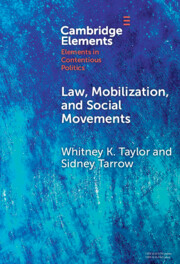Element contents
Law, Mobilization, and Social Movements
Published online by Cambridge University Press: 06 March 2024
Summary
- Type
- Element
- Information
- Series: Elements in Contentious PoliticsOnline ISBN: 9781009493024Publisher: Cambridge University PressPrint publication: 28 March 2024
References
- 5
- Cited by

